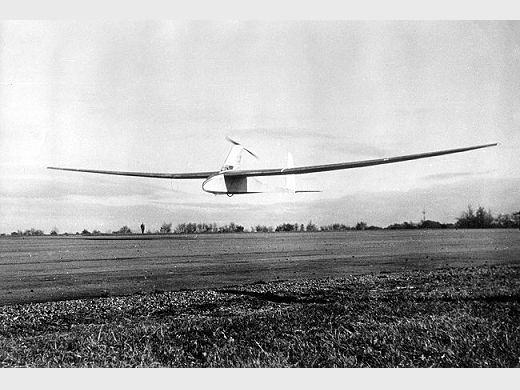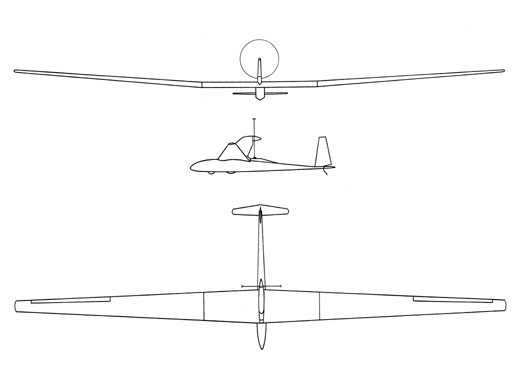| Histoire résumée | Premier vol le 9 novembre 1961 : 15,2 mètres, avec Derek Piggott aux pédales. C’est le premier vol d’un HPA en Angleterre.
Monoplace de vol musculaire dessiné et construit par un petit groupe d'anciens étudiants de l'université de Southampton (Angleterre). Prévu pour participer au Prix Kremer pour le premier vol musculaire au Commonwealth britannique; Ce prix demandait un vol en 8 autour de deux pylônes distants de 800 mètres.
La construction a été partiellement financée par la Royal Aeronautical Society.
It was in the spring of 1960, in the middle of their last term as undergraduates at Southampton University that three students Alan Lassiere, Anne Marsden and David Williams became interested in building an HPA. Marsden was happy with its name being the acronym for Southampton University Man Powered Aircraft, i.e. SUMPAC. The author remembers Susan Roper's comments on this name as "Aren't they lucky they don't have to think up a name for their aeroplane, they've got one automatically"- (nothing about "man" v "person"). The first Kremer Prize had been announced the previous November. The trio had to get their final exams out of the way, and then for the rest of 1960 they investigated possibilities, did tests and drew designs. "We spent ages talking about it before we got started", said Williams. There was very little relevant additional knowledge, materials or experience available in 1960 that had not been available in 1935, and during these 25 years no HPA had flown. The SUMPAC's successful predecessor was the Mufli. The team soon grew beyond the three leaders to include several undergraduates with varying amounts of involvement and commitment. Initial tests of power available were made by people being timed running upstairs; but, after a recumbent pilot position had been chosen, a rig was built for this purpose. The group’s main aim was to get flying as soon as possible, hence the choice of a conventional single seat monoplane. Three main decisions needed to be made with regard to the wing, namely planform, section and method of construction. Today we would add a fourth, the method to be used for lateral control, but in 1960, since ailerons clearly worked for other aeroplanes, they were adopted.
PLANFORM was based on flying at 10 feet (3 m) to comply with the rules of the figure-eight course. A span of 80 feet (24.4 m) was chosen. Their analysis showed that a larger span would require less power, but be more difficult to turn.
Construction started in January 1961. The group were awarded a grant from the RAeSMPAG in February. The plane was transported to Lasham, an airfield in Southern England greatly used by sailplanes, in September. Derek Piggot was the Chief Flying Instructor at Lasham, and became SUMPAC test-pilot. The first flight was on November 9th. Even with his experience he reported that landing was more difficult than taking off.
AIRFRAME PROBLEMS
The dampness of the hangar warped the nose-skinning and slackened the nylon. This meant that extra coats of cellulose dope were added to try to maintain tautness. The tubular framework supporting the pedals and nosewheel collapsed on early ground runs and was replaced with a light-alloy-sheet structure. The original fin was replaced with one of twice the area. The steel transmission belt slipped and stretched.
FLYING On SUMPAC,
The gear-ratio between the wheel and the propeller was adjusted before each flight to suit the anticipated wind-speed, but even so the pilot often found that the wheel was slipping. When speed has increased to the stage that the weight of the plane is nearly all carried by the wings then there will be very little grip because the pressure on the wheel has been lifted. On SUMPAC when the wheel slipped it then became essential to continue to accelerate to full take-off speed, thrust coming from the propeller. Early flights were made at too steep an attitude (i.e. the nose was too high) until Piggot became accustomed to the controls and to the plane. The longest flight was 650 yards (594 m). Turns were attempted, with 80 degrees the best achieved. SUMPAC made a total of 40 flights. Some of the later flights were under tow or with the assistance of a model-aeroplane engine. Instrumentation was a Cosim variometer.
ALAN LASSIERE at IMPERIAL COLLEGE ,the LONDON GROUP
At the beginning of 1963 after 14 months at Lasham, Alan, one of the original three, took the plane to Imperial College to develop it to a hopefully improved performance. The wing was left untouched, the fuselage was virtually rebuilt. The new transmission was by fabric belt, the new forward structure all of light-alloy sheet. The pylon was reshaped to avoid the separation mentioned above. The fuselage was covered with Melinex, (see Glossary). These modifications took twice as long as the original designing and building. SUMPAC was taken to West Malling in 1965. Unfortunately before any improvement in performance could be noticed, a flight on 12th November 1965 ended in disaster. John Pratt, chosen for his cycling ability was aboard. Having flown fifty yards, Pratt found himself at 30 feet (9 m) in a stalled aeroplane, perhaps due to a gust. One wing hit the ground first, breaking it; then the fuselage hit, causing further damage. John Pratt was not injured, but the airframe was considered beyond repair. SUMPAC then became the first HPA to be displayed at the Shuttleworth Collection of historic aircraft. Alan, since then, has created a monumental archive on the subject of HPF. [Human Powered Flying] |




